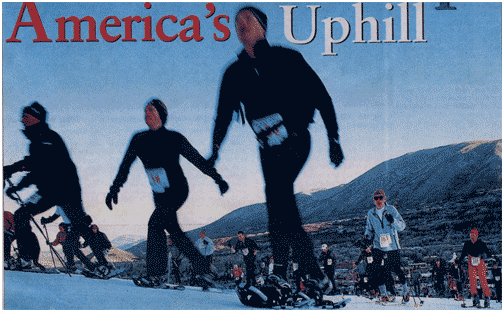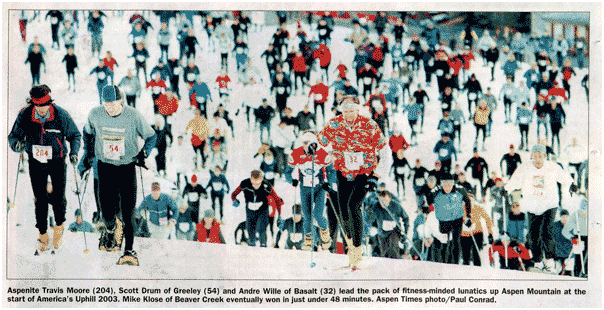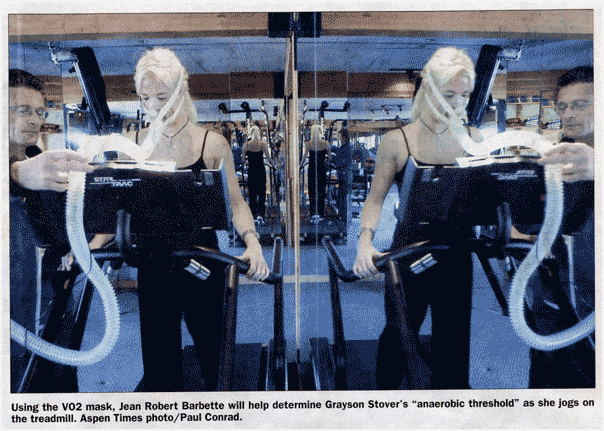
How To Whip America's Uphill
On Saturday, March 20, at 7 a.m., a bunch of lunatics will race up Aspen Mountain for the America's Uphill. There will be lots of spandex, windproof this, breathable that, heart rate monitors, fancy eyewear and all kinds of tech-talk about equipment and strategy and methodology and philosophy and how-not-to-puke-ology. Top contenders can haul butt up Ajax in less than an hour, as if the steep 3,267-foot vertical climb at altitude doesn't require, like, slowing it down a bit. These aliens love to talk flippantly about racing up mountains like it's normal. Most of them have been doing it all season as part of the local BASH Uphill Series. They will tell you how long it took them last year, but the conversation doesn't stop there. Some will debate that power-hiking might be faster than running. Some like to use poles, some don't.

Skis or snowshoes? It all depends on the conditions, of course. These psycho-athletes seem to be born with sinewy, fat-free bodies and the lungs of superheroes. Like most of us, I get out there and run and hike and bike and snowboard, but these uphill creatures are a different breed. Smuggler Mountain on a warm spring day is enough to get my heart racing, even if I do it five times a week. So what separates me from them? How come I work out all the time, yet the only thing that's "easy to go up" is my weight?

The magic number: Anaerobic Threshold
"You need to know your 'magic number' or Anaerobic Threshold [AT] to get the most out of your workout," says Jean-Robert Barbette, head trainer and owner of Jean-Robert's Gym. "I get clients who run up Smuggler every day and are frustrated because they're not getting stronger or losing weight, and they don't understand why. Training effectively and efficiently has everything to do with knowing what these numbers are and working to improve them."
Jean-Robert uses the results of a cardiovascular analysis to customize every client's workout plan, whether it's a competitive athlete who wants to improve performance, an active person who wants to tone up and slim down, or someone who is recovering from illness, trauma or injury. Jean-Robert deduces three key measurements: 1) VO2 max, the amount of oxygen the body uses during exercise (basically heart and lung capacity), measured in milliliters. 2) Anaerobic Threshold (AT), the point at which body metabolism changes from aerobic to anaerobic, muscles start to produce lactic acid, and burn more sugar than fat. This number is measured in beats per minute and/or percentage when compared to 3) Max Heart Rate, the fastest rate at which your body can pump blood before you think you're going to throw up or pass out. Basically your AT is your limit, that invisible line that can only be crossed for short periods of time (approximately 20-25 minutes) before you hit the wall.
For a competitive athlete, raising that number means being able to go faster, longer. For someone like me, knowing my AT means knowing how to train more efficiently so I can achieve my goals without getting frustrated, hurt, or burned out. "The person who performs the best is going to have the highest AT," says Jean-Robert. "To help improve that number, we do the test and develop a cardio program that integrates interval training and recovery workouts to strengthen the heart and lungs gradually. The idea is to just tap that number enough that it gets higher." Jean-Robert says his clients who follow the program see a 15 to 20 percent increase in their AT within three months.
Bill Fabrocini, of Carmichael Training Systems Performance Center, explains it like this: "Think of it like a race car. The VO2 is like the size of your engine. The AT is how high you can rev that engine. Someone like Lance Armstrong has a huge engine, and he can rev it high for a long time without frying it because he has a very high AT, at about 95 percent of his max heart rate. "We know from research that VO2, the size of your heart and lungs, is going to depend more on genetics, but there is a lot you can do to raise your AT with proper training. The goal isn't so about a high VO2 as getting that AT number as close to the max heart rate as possible." Lance Armstrong's VO2 max is 85. Mine is 38.

Truth in Numbers
Jean-Robert hooks me up to this machine on wheels that looks like something you'd expect to see in the hospital. The test entails a quick 10-minute jaunt on the Treadmill, wearing a frightening mask over my nose and mouth that's held in place by wrapping two snug plastic straps around my head. If I get claustrophobic, Jean-Robert says, he can rip the mask off in a split second. A long plastic tube that goes from the mask to the machine measures how much oxygen my lungs take in and how much carbon dioxide they let out. My breathing is loud and laborious like Darth Vader, but Jean-Robert allows me plenty of time to get used to breathing with the mask on at an easy walking pace before gradually increasing the speed to a steady jog and then to a run. I can talk with the mask on to let him know I'm OK when he asks. The all-out, sprint-until-you-die torture I expected is not part of the process. While I am out of breath and drooling all over the mask, it's uncomfortable but not unbearable. The test is over in less than 15 minutes.
Common Mistakes
“When people don’t know their AT, the margin for error is huge,” says Jean-Robert. “If you are training at 130 [beats per minute] and then we find out you should be at 150, the difference is going to be 200 calories an hour. At the end of the day, end of the week, end of the year, that’s the difference between being 15 pounds overweight and being fit.” I admit that while I do change up my workout in terms of venue (Smuggler, Ute Trail, Independence Pass, Rio Grande), I tend to do the same one-hour run at the same pace. According to Jean-Robert , I’m not going to get any stronger doing the same medium-intensity workout. Not only will I see no improvement in my AT, my heart rate is too high to burn fat efficiently. And as soon as I get home and have my little post-workout snack, I’m going to replace all the sugar I just burned.
“People get into a specific pattern of doing the same workout and don’t add enough variety,” says Fabrocini. “That is a big trend, especially in Aspen where people find their favorite trail and stick with it. Variability is the most important aspect of training and the most important concept in overall health and performance.” Jean-Robert says another common problem are those “target heart rate” posters you see in all the gyms that tell you to take 220 and subtract your age. “Those charts are bogus. That formula was devised 30 years ago and doesn’t work for most people. I’ve conducted hundreds of tests and I’m always amazed that everybody has a different AT, regardless of their age,” says Jean-Robert . “The only way to get those numbers is to do the test.”
Get Into The Zone
It turns out my VO2 max, while far from Lance Armstrong's, is slightly above average. Jean-Robert devises a cardio training program based on my "magic numbers" and gives me a heart rate monitor so I know what they are. I'm far from a tech-head, but the digital watch that measures my heart rate from the plastic monitor that I tuck under the lower seam of my jog bra is like a new toy. It's easy to use and fun to play with. It's fascinating to see what my heart rate does during different exertion levels. I find my heart rate is usually much higher than what Jean-Robert prescribes for my "target/fat-burning zone" and often rises quickly without warning, say when I go from a walk to a slow jog. He sets the watch so that it beeps and blinks frantically whenever I go over my target heart rate — the point at which I start burning more sugar than fat.
I'm given a program that rotates three different cardio workouts: a fat-burning /recovery day that's long and slow, a medium-intensity workout with six to eight sets of three-minute intervals where I go a little harder and recover for a minute in between, and then a high-intensity day where I do a half-hour all out, with shorter rests in between. The slow day is way slower than my usual pace, but I can go longer more comfortably than I could before. The interval days change up my routine so I'm not as bored, and between timing the intervals and watching my heart rate I'm completely entertained, pushing myself harder than I would have without the monitor. Faster, faster, faster!
While I'm just trying to get up off my fat butt and improve my fitness, Jean-Robert says it's critical for competitive athletes to monitor their AT. "In a race like America's Uphill, people who don't know their AT will tend to follow the race pace and blow up because they just can't sustain at that level."
Matt Carpenter, the course record holder and three-time winner of America's Uphill, has a VO2 max of 90.2, the highest ever recorded in the United States. Knowing these numbers will not only help performance, he says, but using a heart rate monitor during workouts teaches an athlete to understand what's going on with their body. "It's important to learn what happens and when it happens and why it happens so you can better anticipate how you're going to perform under different circumstances.
It teaches you how to shift gears and adjust your pace and how to back off at the right time so your heart doesn't spike too high. It's an invaluable tool, like a speedometer is for a car." Carpenter says a seasoned athlete also needs to rely on instinct. "There are tools available to help monitor the science. However, it is the art of knowing when and how to apply the science that is most important. Otherwise many athletes risk paralysis by analysis." His secret strategy to winning so many endurance races? "Go out hard, and when it hurts — speed up," he says with a chuckle.
By Alison Berkley for Aspen Times Weekly
